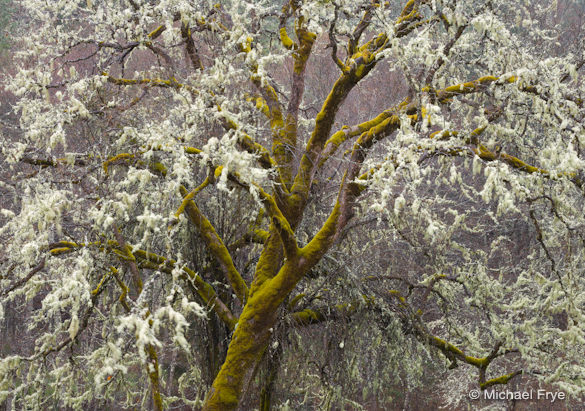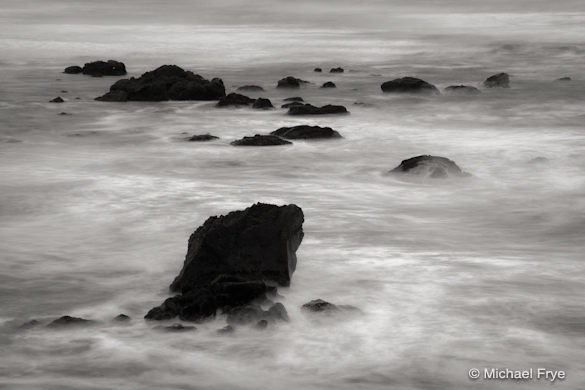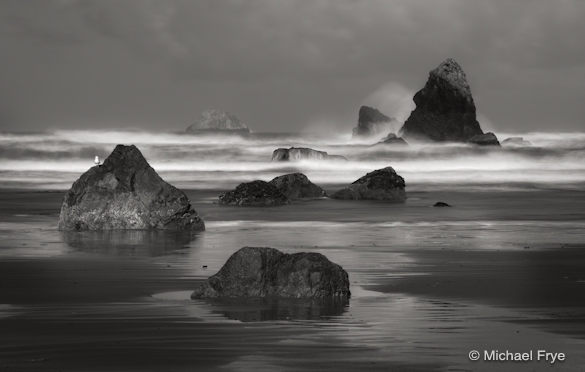Claudia and I are in Humboldt County this week visiting our son Kevin, who’s a junior at Humboldt State University. This is redwood country, along the far northern coast of California. It’s a temperate rain forest, and it sure seems like it this week. It’s been raining—a lot. Yesterday we had a break, and a mostly rain-free day, but another storm arrived today, and the area is expected to get six to ten inches of rain over the next two days.
Although we’re mainly here to visit our son, of course I hoped to do some photography in this beautiful area as well. The main challenge of photographing in the rain is keeping the camera dry. I’ve tried many different ways of doing this: umbrellas, towels, plastic bags, etc, but there’s no perfect solution. Various people make rain covers for cameras, which work pretty well, but only for telephoto lenses. In fact it’s a lot easier to photograph with long lenses in the rain, regardless of what kind of cover you put over the camera, because you can use a long lens hood to keep rain off the front glass. Hoods for wide-angle lenses have to be short, to avoid vignetting, which makes it difficult to keep water from splashing onto the front element. The best solution I’ve found for wide-angle lenses is to attach an umbrella to my tripod with a clamp. This works, but it’s awkward.
The other challenge with photographing in the rain is the light. Overcast, soft light doesn’t often work for big, sweeping landscapes, but it’s perfect for many smaller scenes, and its especially good for bringing out colors and color contrasts. Driving over Highway 299 from Redding on Tuesday we saw many beautiful oaks decked with light-green lichen. Some of these also had deep green moss along their trunks, the color made even more vibrant by the moisture. It was raining hard, but I couldn’t resist stopping several times to try and photograph these trees. This time I had something even better than a towel or plastic bag to help keep my camera dry—an assistant (Claudia) holding an umbrella! The image at the top of this post shows one of the these trees.
Yesterday morning I drove to a spot along the coast near Trinidad with some interesting rocks and sea stacks. It had stopped raining, but initially the light was flat, and the scene was gray—dark gray rocks against light gray water. I could have just thought, “This won’t work,” and given up. But since I wrote that post about breaking routines a couple of weeks ago I decided to see what I could do with the “wrong” light for the subject. The gray palette suggested composing scenes that would work in black and white, and I thought that slow shutter speeds might transform the scene and create some textural contrasts—hard rocks and soft water. I used a variable neutral density filter to cut the amount of light reaching the sensor, which allowed me to use shutter speeds of six seconds or longer, even after the sun finally broke through. I’ve posted two of these images below.
If we only break out our cameras when the light is spectacular, we won’t make many photographs. And I think we limit ourselves with ideas about what “good” light is, or what the best conditions are for a certain scene or subject. We sometimes make more creative and satisfying photographs when we’re forced to stretch ourselves and adapt to less-than-optimal conditions. “Bad” weather can be good for the imagination.
—Michael Frye
Related Posts: Breaking Routines; Capturing a Mood; The Third Dimension in Photography
Michael Frye is a professional photographer specializing in landscapes and nature. He is the author and photographer of The Photographer’s Guide to Yosemite, Yosemite Meditations, and Digital Landscape Photography: In the Footsteps of Ansel Adams and the Great Masters, plus the eBooks Light & Land: Landscapes in the Digital Darkroom, and Exposure for Outdoor Photography. He has written numerous magazine articles on the art and technique of photography, and his images have been published in over thirty countries around the world. Michael has lived either in or near Yosemite National Park since 1983, currently residing just outside the park in Mariposa, California.












A great part of this great state. Love the shots.
I appreciated the breaking routines post a while back. I put on my Soviet-made Jupiter lens and walked around the yard. Daffodils, fruit tree blossoms and snow. Good times.
Cheers,
~Peter
Nice Peter – glad that post helped give you a nudge.
I really like the tree shot and the sea stacks, nice job taking advantage of the conditions. This is a timely topic for me – I just returned from Guilin, China and never once saw the sun. The hardest part was clearing my head of the photos I had hoped to take so I could focus on what was actually there. It is still painful, though, having to abandon what you wanted to achieve.
Thanks for sharing these thoughts Kyle. It is indeed difficult to let go when we hope for certain conditions, but sometimes good photographs come out of that. When we return from a photographic trip it often takes some time to gain objectivity, and appreciate what we were able to capture, rather than focus on what we missed.
I can’t tell you how grateful I am to read this post. As a beginner in rainy western Washington in an extraordinarily rainy year, I have been struggling with getting myself out to shoot in what I’m afraid I’ve begun to think of as this “flat gray light.” But wait! I *love* black & white photography. This is my chance. Your photos and your blog are an inspiration and a kick in the butt. Thanks!
Glad you found this helpful Linda. That “flat gray light” can be great for many subjects, and can work for colorful subjects as well as black and white. It usually helps to keep the sky out of the frame though, as that bright, washed-out, overcast sky pulls attention away from more interesting things below. So that’s why I say that soft light usually works better for smaller subjects, where you can keep the sky out of the frame.
Michael, it is great to see what you would do outside of the mountains. Especially, the second photograph.
Thank you Lenya!
Michael,
It is always a pleasure to read your tips on your blog. Photographing in B&W during bad weather is great. All Ansel did was B&W and we are so worried about “good light” nowadays. I am now starting to experiment with infrared which is best in mid day when there is “bad, harsh light”. We need to break our routines and just have fun shooting! Thanks for reminding us to get out of our comfort zones.
Thanks Karl – you’ve added some great thoughts here.
Great examples of being flexible in what you photograph, Michael. I really like the shape of that tree, and the moss and the lace lichen. The rain is a fine substitute for foggy conditions in that one. I really like the second of the two rocks and sea stacks shot. Love that wave crashing on the larger of the stacks! Plus the waves create some great layers that the B&W conversion really highlights.
Thanks Vivienne! It was fun to photograph some different subjects, and especially to try the slow shutter speeds with the ocean waves.
Your efforts in marital politics and dealing with nature yielded excellent results.
My shooting time is usually 10 a.m., so I often use HDR, or I composite frames with different exposures. I’m no Ansel Adams, but I enjoy walking in the sunshine, taking photos, and processing them in Lightroom and Photoshop. Then I enjoy looking at my photos, bad light notwithstanding.
BTW, after dealing with the Tone Curve issue, I am finding Lightroom 4 extraordinary in its rendering of my photos. The initial rendering is so good, it is leaving me with very little to do!
“Marital politics” – LOL! I’m glad you’re able to turn “bad” light into good times, and hopefully some good photos as well. And I’m also happy that you like Lightroom 4 – me too.
Hi Mike, I envy the choice and location your at right now, the area around trinidad is awesome. hope you get some nice weather conditions and enjoy your time there.
Jesus
Thanks Jesus, and yes the seashore around Trinidad is great.
All 3 images are very striking! The third one is really impressive!
Shooting digitally we have the freedom to take more pictures and experiment to see if something will work or not. After all that’s what makes photography fun right!
Absolutely – the ability to experiment does make photography more fun, and digital cameras encourage that. I think when people look back on this era of photography they’ll see an explosion of creativity. Some of the experiments will seem like bad ideas later, but some will hold up and stand the test of time.
Like a number of others, I’m finding this and the previous “Breaking Routines” post of particular relevance – many thanks for posting these Michael, very thought provoking. I do definitely have my favoured subjects, time of day (dawn / dusk), and quality of light. Hence I get into a mindset of “light not good, won’t take any shots”. And like the man said, “if you do what you’ve always done, you’ll get what you always got”.
Nice quote Paul. Who was “the man” who said that? 🙂
Michael, bad weather?? We need some of that here in Colorado (especially for those fires southwest of Denver). Maybe next Mon or Tues we will get some rain/snow according to the forecast. Blue sky and sunshine can sometimes get boring. Whoa … I can’t believe I said that!
As for LR4, I installed it last week and, so far, am very impressed!
I heard about those fires – very strange for March. It was surprising to see so little snow on the ground in mountainous Colorado pine forests this time of year.
And I can’t believe you said that either!
Thank you for setting such a great example, Michael. All of these images are just beautiful. I’m inspired to not give in to the rain.
You’re welcome Joolz, and I hope you get some great rain photos!
Thanks for your post.I love all the 3 shots but prefer the last one.
I also have installed the LR4 last week and love it. Are you planning a Light and land 2?
I hope so…
Thanks Maria! I’ll be posting more about Lightroom 4 here soon, but I’m also thinking about the best way to offer something more in depth. Maybe Light & Land 2, or an online class – or both.
I am looking forward to Light and Land 2!
Great points, especially noteworthy is that you posted some nice b/w images. Many people will forget that this type of weather can be great for getting dramatic b/w photos.
Thanks Alan. Black and white is always a good choice for scenes that lack color – but I don’t want to give the impression that it’s only for “bad” light. Black and white works for all kinds of light.
I clamped an umbrella to my tripod many years ago when I was shooting film on a 120 camera. Was very pleased with myself as it kept off the rain while I changed film backs. All going very well until a gust of wind blew the whole thing over.
Ouch! Like I said, there’s no perfect solution, and you just pointed out the biggest drawback to the umbrella and clamp.
Beautiful and inspirational photographs, Michael. I particularly love the oak and the bands of light and dark in the second shot with the sea stacks.
Thanks Ian!
Michael,
My daughter is also a Humboldt junior. Two weekends ago when I drove her back up after spring break we went to Patrick’s point. My “breaking routine” was shooting in bright midday sun along the coast. I broke out my ND16 filter & had fun with swirling patterns in the breakers. It’s a beautiful area all through there & I always try to fit in some photography.
I really enjoy the lighting on the sea stacks in your second B &W.
Ted, there seem to be a lot parents of HSU students reading this blog. I don’t know what that means, but it’s interesting! Glad you found a way to work with some “bad” light up there – it’s a great area with, I think, lots of untapped potential for landscape photography.
Michael, it looks like the “wrong light” was exactly the right light for those black and white seascapes. 🙂
Dan
Thank you Dan!
Excellent post and lovely photographs, Michael!
Thanks David!